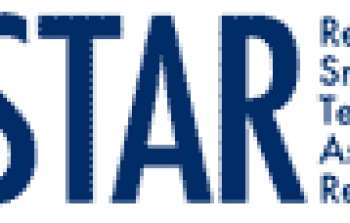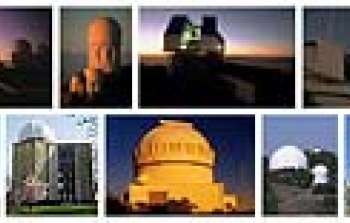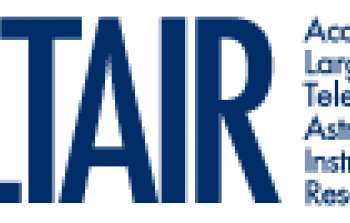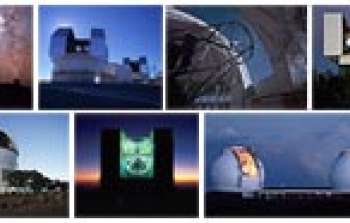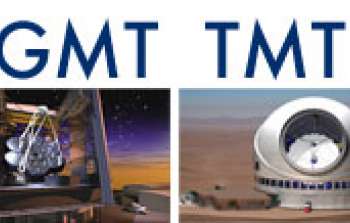sci08016 — Announcement
Update from NOAO Director David Silva
November 30, 2008
The annual NOAO Town Hall will be held on Tuesday, 6 January 2009, from 12:45 to 1:45, at the Long Beach AAS meeting. We invite everyone to attend.
With 2008 drawing to a close, I would like to draw your attention to the recent System development activities at NOAO and activities related to the Decadal Survey. In some cases, these items update the information provided in the December issue of the NOAO Newsletter. I will provide further updates and solicit community discussion of these topics at the NOAO Town Hall at the January AAS meeting. I look forward to seeing you there and hearing your thoughts. If you will not be able to attend the Town Hall, please send your thoughts on the topics below to currents@noao.edu.
The Decadal Survey, NOAO, and the US O/IR System
ASTRO2010, the next Decadal Survey, is upon us. As in previous decades, the role of NOAO is likely to be discussed as part of the Survey deliberations. To place this topic in context, the previous (2001) Decadal Survey report recommended that “US ground-based optical and infrared facilities…should…be viewed by the National Science Foundation (NSF) and the astronomical community as a single integrated system drawing on both federal and non-federal funding sources.” Subsequently, the 2006 NSF AST Senior Review panel further asserted that NOAO should lead a NSF-funded base program that delivers “…community access to an optimized suite of high performance telescopes of all apertures.” Within the US community, this base program has become known as the System.
NOAO has been responsive to these directives, as described in previous issues of Currents. At the NOAO Town Hall meeting at the January AAS meeting, I will describe our progress to date, and present my thoughts and invite community input on the further evolution of NOAO and the US System.
As part of the effort to provide input to the Decadal Survey, AURA has appointed a committee to assist NOAO in developing possible System roadmaps for the next decade. The committee is led by Tim Beers (Michigan State University). The committee membership and draft charge are available at the Future of NOAO within the System committee Web site. Important starting points include recommendations from the NOAO Users, ReSTAR, and ALTAIR committees. The “Futures” committee will also remain cognizant of existing LSST and GSMT plans and schedules. Their first meeting will be held immediately after the January AAS meeting in Long Beach.
Renewing Small Telescopes for Astronomical Research (ReSTAR)
Many of you had the opportunity to read and comment on the NOAO white paper describing the plan to implement the recommendations of the ReSTAR committee (see the August 2008 issue of Currents). The ReSTAR committee reviewed the US System of O/IR facilities in the 2- to 5-m aperture range. Both the ReSTAR committee report and the white paper describing the implementation plan are available at the ReSTAR committee Web page. Based on the NOAO white paper, NOAO submitted in November a proposal to the NSF for supplementary funding in order to implement the highest priority ReSTAR recommendations: new optical and near-infrared spectrographs for the Mayall and Blanco 4-m telescopes, public time on the Palomar 200-inch, as well as an echelle spectrograph for the Discovery Channel Telescope. Further details on the proposal, as well as opportunities for involvement in the next stages of the implementation plan, will be described at the NOAO Town Hall meeting.
Access to Large Telescopes for Astronomical Instruction and Research (ALTAIR)
The ALTAIR committee held their third face-to-face meeting in Dallas on 19 – 20 November. The discussion centered on developing a strategy for enhancing the system of large (6.5- to 10-m) telescopes over the short- and long-term via mechanisms such as the Telescope System Instrumentation Program (TSIP), which provides public access to the non-federal facilities, and the US investment in the Gemini Observatory. Preliminary recommendations and an early version of the committee report are now being drafted. The final ALTAIR report is likely to be made public in the first quarter of 2009.
GSMT Community Assessment Panel
Whither Federal involvement in a Giant Segmented Mirror Telescope (GSMT)? This is one of the many System-related questions that ASTRO2010 will address. To provide input to these deliberations, NOAO has commissioned a community assessment panel in coordination with the NSF. Led by Dr. Tony Beasley, Project Manager of the National Ecological Observatory Network (NEON), this independent panel will assess the status of the Giant Magellan Telescope (GMT) and Thirty Meter Telescope (TMT) projects. The panel is not charged with comparing the projects but only assessing the current status of each project in terms of items such as schedule credibility and estimated total lifecycle cost, as well as current progress towards construction readiness. Separate reports on each project will be generated and delivered to NOAO for transmission to the NSF and ASTRO2010. Further discussion of this community assessment will appear in a future issue of Currents and in the NOAO Newsletter.
Budget
Like all organizations supported by the Federal government, NOAO is waiting for a final FY09 budget and the proposed FY10 budget. There are hopeful signs that the Obama Administration will support level or increased NSF funding. Nevertheless, nothing is certain at this point.
Contacts
currents@noao.edu
About the Announcement
| Id: |
ID
sci08016
|

